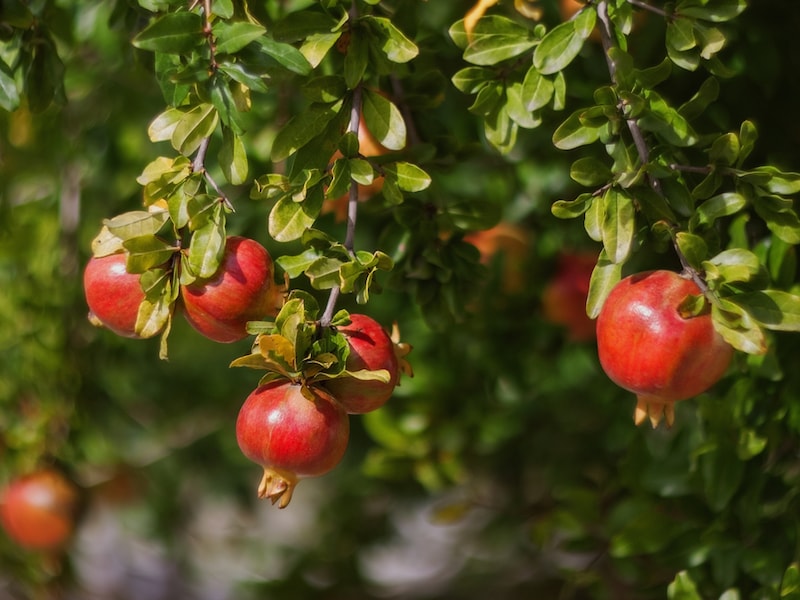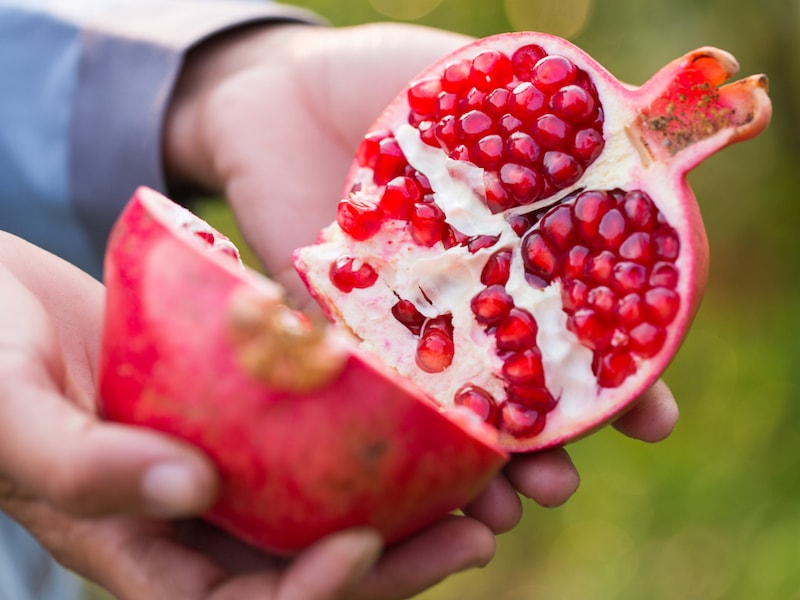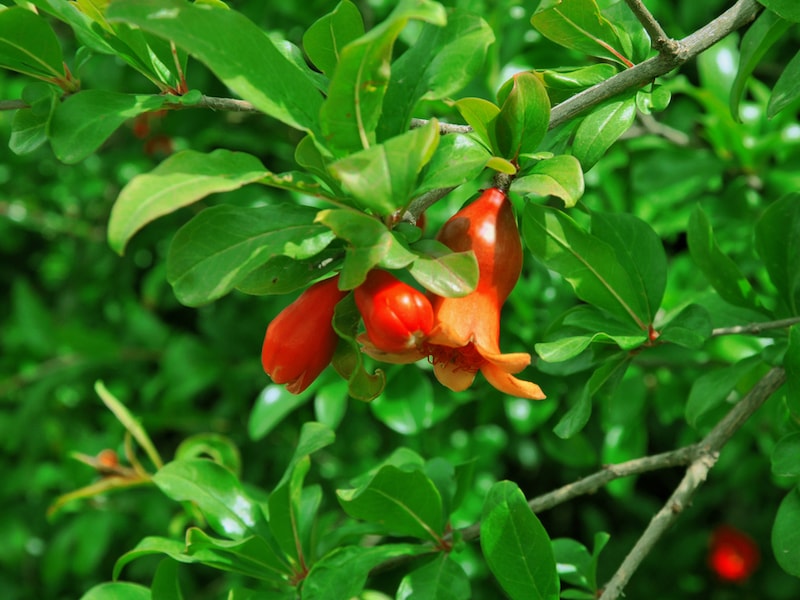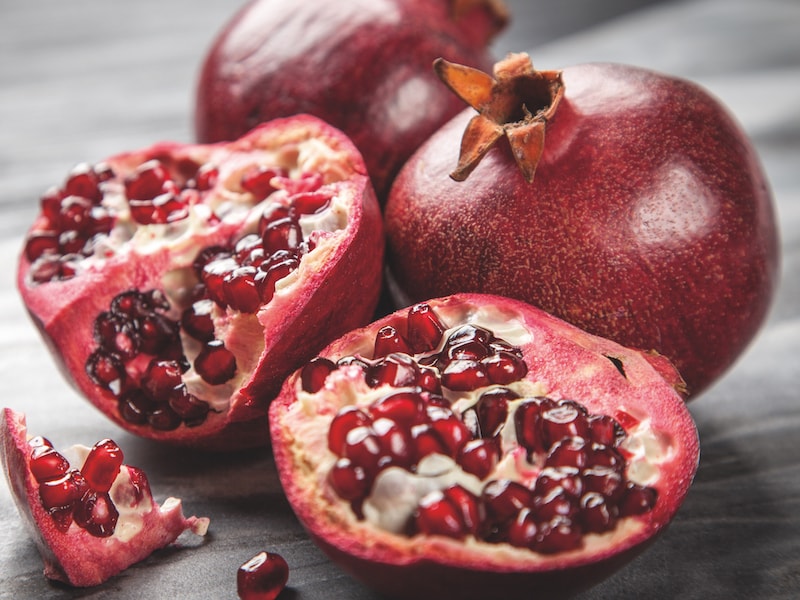With delicious sweet-sharp juice and jewels of bright pink pulp, pomegranates are an exotic fruit that originated in Iran. Featuring glossy deciduous leaves, gorgeous ornamental flowers and large red fruits, pomegranate trees can be grown in the ground or containers in most parts of the UK. Just one of the many fruit trees sold online at Suttons, here’s how to get your new pomegranate tree off to the right start…
Can you grow pomegranates in the UK?
Pomegranate trees will grow happily in the UK provided you choose the right variety. One of the best options is pomegranate ‘Provence’. Self-fertile and hardy down to -5°C, this traditional French variety is very well suited to growing in a sunny outdoor spot in the UK. In colder or less sheltered locations, it may fare better in a greenhouse.
Pomegranate ‘Provence’ bears vibrant, funnel-shaped orange flowers in June followed by beautiful leathery-skinned fruits that mature between September and November. Although it’s low-maintenance and self-fertile, having a second tree nearby will improve fruit set.
How to plant your pomegranate

Image: Dmitrenko Ekaterina/Shutterstock
Pomegranate trees love the sun so, for best results, plant your tree against a south-facing wall. Choose a spot with well-drained, slightly acidic, soil. Not sure what sort of soil you have? A home testing kit will help you work out the pH levels in different parts of your garden. If your soil is very alkaline, simply grow your pomegranate in a container and mix a few handfuls of ericaceous compost into your potting mix.
If you have the option, grow your pomegranate in a greenhouse or conservatory for more reliable fruiting. In colder northern areas, it’s best to grow your tree in a large container so you can move it into a sheltered area overnight when deep frosts are predicted.
Pomegranates are drought tolerant, but they do appreciate watering during the summer. Water thoroughly straight after planting, and every few days for the first two weeks. After this, allow the soil to dry out between watering.
In their native habitat, pomegranate trees tolerate very dry, poor soils so don’t really need extra feeding if they’re planted in the ground. For container-grown trees, remove the top layer of soil and replace it with fresh compost every year or so. If you want to feed, be careful not to overdo it – a nitrogen rich fertiliser once or twice a year is enough.
How to prune your pomegranates

Image: Victoria Atu/Shutterstock
Prune your pomegranate tree to remove any dead or damaged branches during the growing season using clean and sharp equipment. Then give it a proper structural prune during its dormant period in the winter months, before bud break in the spring. Cut the branches back to outward facing buds to create the shape you want.
A young pomegranate tree naturally has a few leading stems rising from the ground. Keep to three or four main stems by removing suckers as the base. If you notice any crossing stems in the centre remove them too, keeping your young tree open with good airflow.
How and when to harvest pomegranates

Image: Retan/Shutterstock
Pomegranate fruits need a long period to ripen properly – between five and seven months depending on the summer weather conditions. Fruits should set after flowering in early summer, and ripen through a mild autumn ready for picking in October or November.
Pomegranate fruits are ripe when the sides of the fruit are angular and flattened, rather than rounded in a perfect sphere. A ripe pomegranate should feel heavy on the tree, showing the seeds inside are plump and filled with juice.
Quick tips for growing pomegranates

Image: vividvic/Shutterstock
Here are our quick tips for growing pomegranates:
- Climate. Pomegranates are native to Iran, and have been grown across the middle east for thousands of years. They cope very well with arid hot landscapes, and don’t really need too much water or extra fertiliser.
- Time. Expect your pomegranate tree to fruit three years after planting, and to take six years to crop properly at its full capacity.
- Pollination. Pomegranates are pollinated by insects, so make sure you attract plenty of pollinators to your garden by planting a few flower seeds for bees and butterflies around your fruit tree.
We’d love to see your pomegranate harvest. Share photos of your trees with us on social media using #yoursuttonsjourney, along with any tips from your neck of the woods.
Lead image: Pomegranate (Punica granatum) Provence from Suttons
Last Updated on February 10, 2025 by Suttons Horticultural Team





